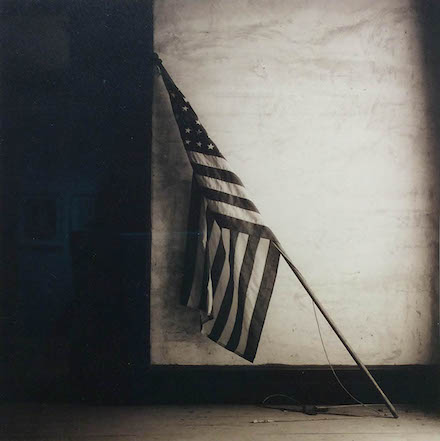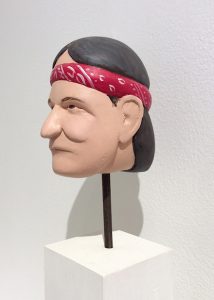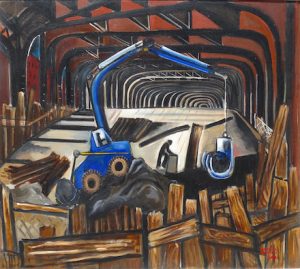(HUDSON, N.Y.) – “Americana,” a new exhibit that stages concrete and abstract symbols of American values in a striking selection of ballpoint pen drawings, wood and cardboard constructions, paintings, and photographs that recall contemporary “artifacts” relating to American history, culture, and tradition defined by previous centuries, is on view at Carrie Haddad Gallery through Sunday, March 12.
Linda Newman Boughton’s life-sized ballpoint pen drawings of notorious Civil War soldiers pay a reverent homage to some of our earliest freedom fighters. Inspired by a collection of photographs taken by Mathew Brady, one of America’s first photographers best known for documenting the Civil War, Boughton imparts a vibration to the memories of historical icons with frenzied, yet contained movements of ballpoint pen. Static symbols of bravery and courage are softened with Boughton’s touch of whimsy derived from her mundane medium as we revisit a generation who secured life and liberty for our future.
Frank Litto produced a unique series of three-dimensional wall sculptures deemed The Great American Wheelworks from the early 1960s until the ‘80s. Litto’s ingenuity and thorough understanding of the wheelwright craft fools the eye into thinking that the 1/2 inch thick wood and faux metal finishes appear to be deceptively real. J
John Cross’s hand-carved wooden figures have personified numerous icons in American pop culture including music, sports, and the arts.
David Halliday reaches into his archives of images to compile a selection of sepia-toned photographs mixed with more recent color works; each are iconic representations of the most ordinary objects of everyday life. Together they represent a fading essence of things quintessentially ‘American’. For the artist, beauty and nostalgia are pervasive, but lamentation has its role as well, particularly now having crossed the threshold into the New Year.
For anyone raised in the country, Harry Orlyk’s impressionist oil paintings spark a sense memory that is at once shared and deeply personal. His work evokes a return to days spent as a kid when you played behind “Old Hap’s Barn”, or played hide-and-seek in the cornfield. If raised in the city, Orlyk’s paintings illustrate what you fantasized living in the country would be like. With each changing day and season, Orlyk reminds us of the simplistic beauty inherent in rural, small town America.
Andrew Buck has always been inspired by landscapes and their ability to embody both abstract and tangible characteristics. Photographed in several rock quarries on the East Coast, the series of Rockface prints are examples of man’s determination to reconfigure natural landscapes to cater to our specific needs. Buck photographs the large walls of rock that have been blasted with dynamite and eliminates any evidence of scale to produce a strikingly abstract image.
Russell DeYoung bridges the divide between the abstracted and the familiar with the prints Red, White, and Blue, Upstate, which are inspired by the landscape of impermanence and imperfection the artist observes in his living and working spaces in the Hudson Valley and New York. Made in collaboration with Flying Horse Editions of Orlando, Fla., in 2009, the edition of ten prints, made of professional grade Art Care cardboard, are modeled to replicate DeYoung’s 15×12 constructions of discarded cardboard, which are stitched with string and painted with modified latex. Through the use of modest scale, a limited palette and plebeian materiality, these works offer an alternative to the bombast nature of recent American culture. Exhibited in pristine white shadow box frames, the work calls attention to forgotten utilitarian objects and an overtly materialistic society.
Self-taught painter Arthur Hammer is perhaps best known for his work that evoked the WPA style of painting associated with American artists emerging in the 1920s, ‘30s and ‘40s. Landscapes, industrialized cityscape views, construction machinery and portraiture were among the most commonly painted subjects during his career which spanned more than 40 years.
Carrie Haddad Gallery is located at 622 Warren Street in Hudson, N.Y., and is open daily from 11-5pm.
.



